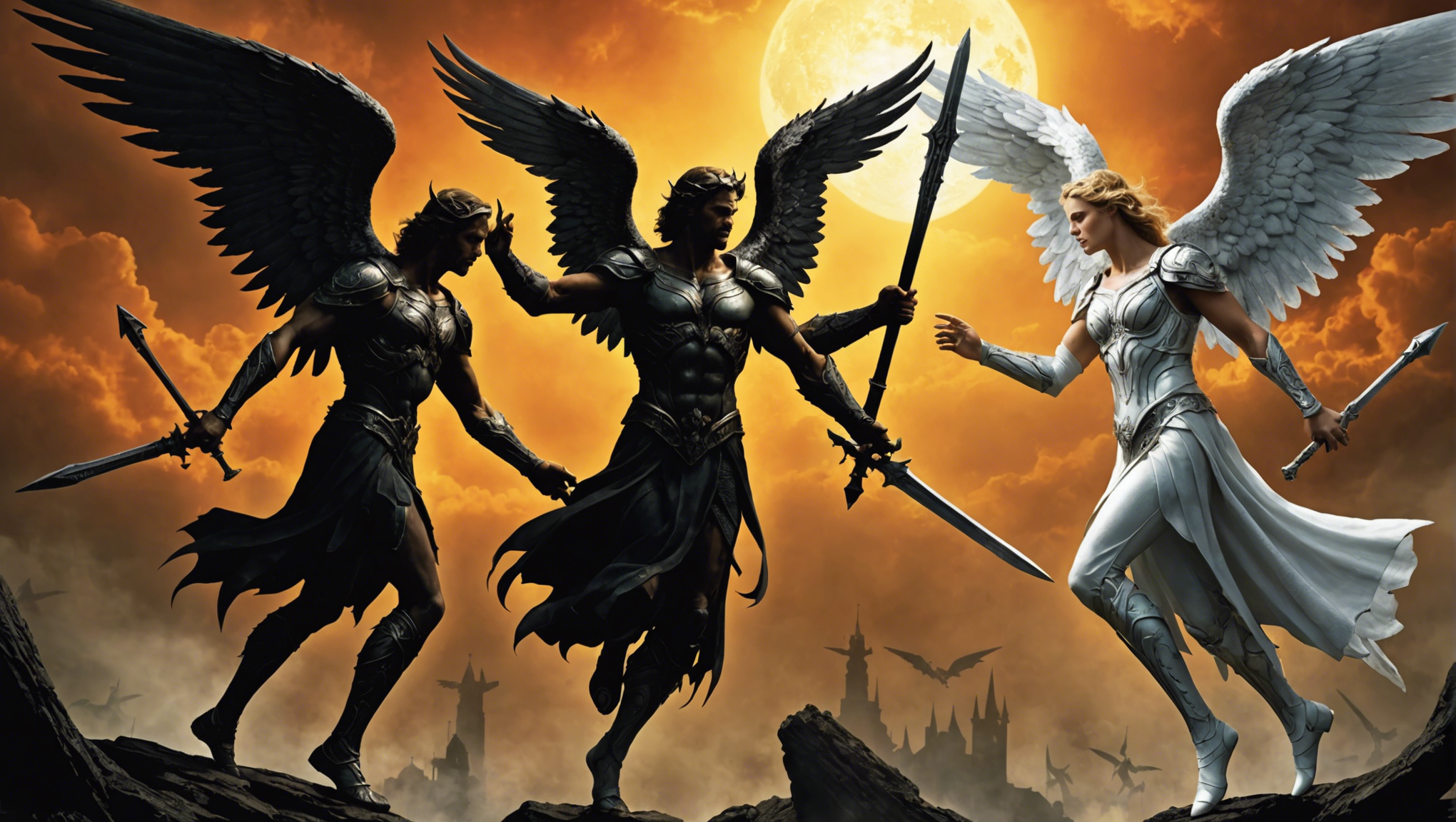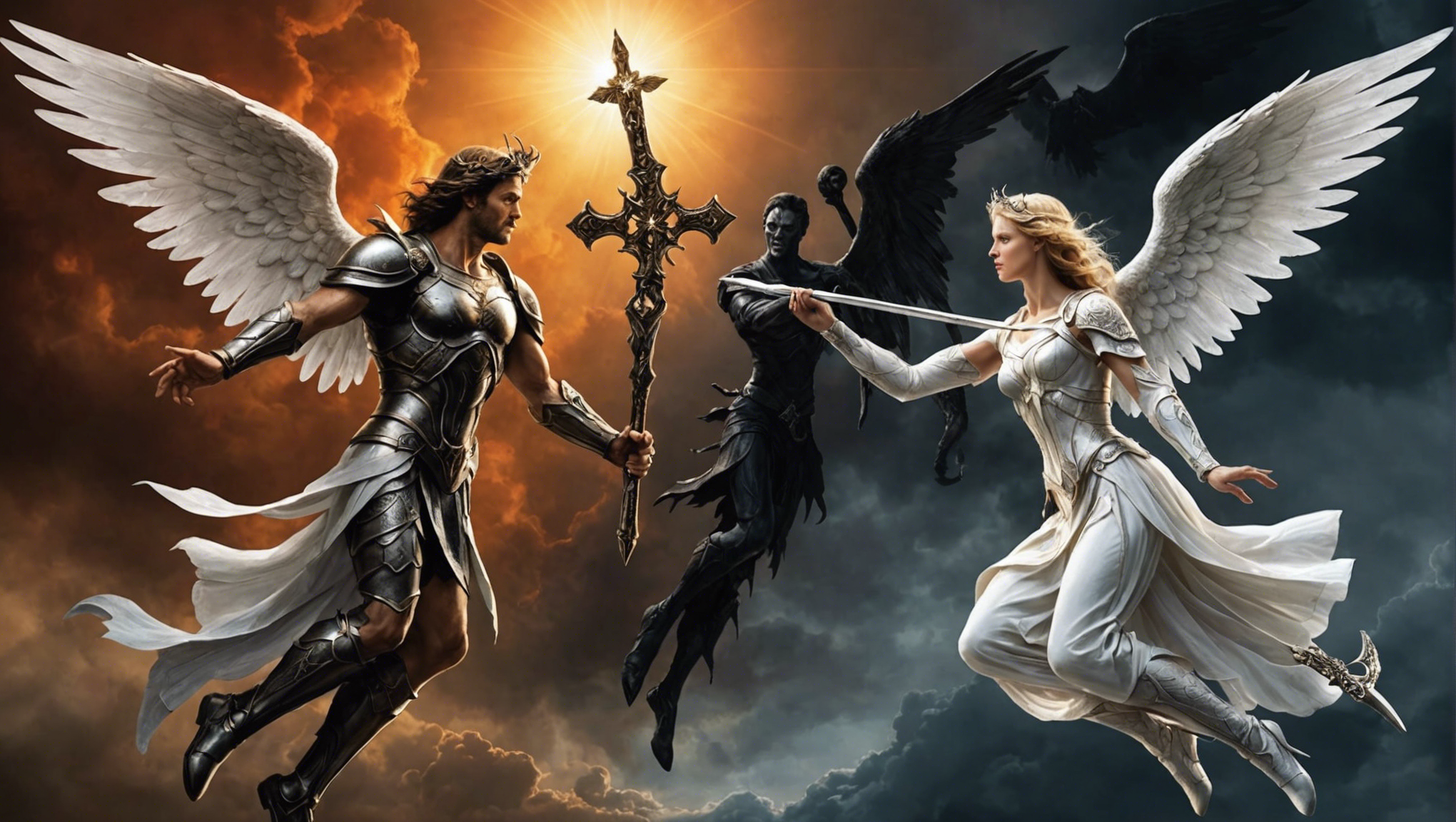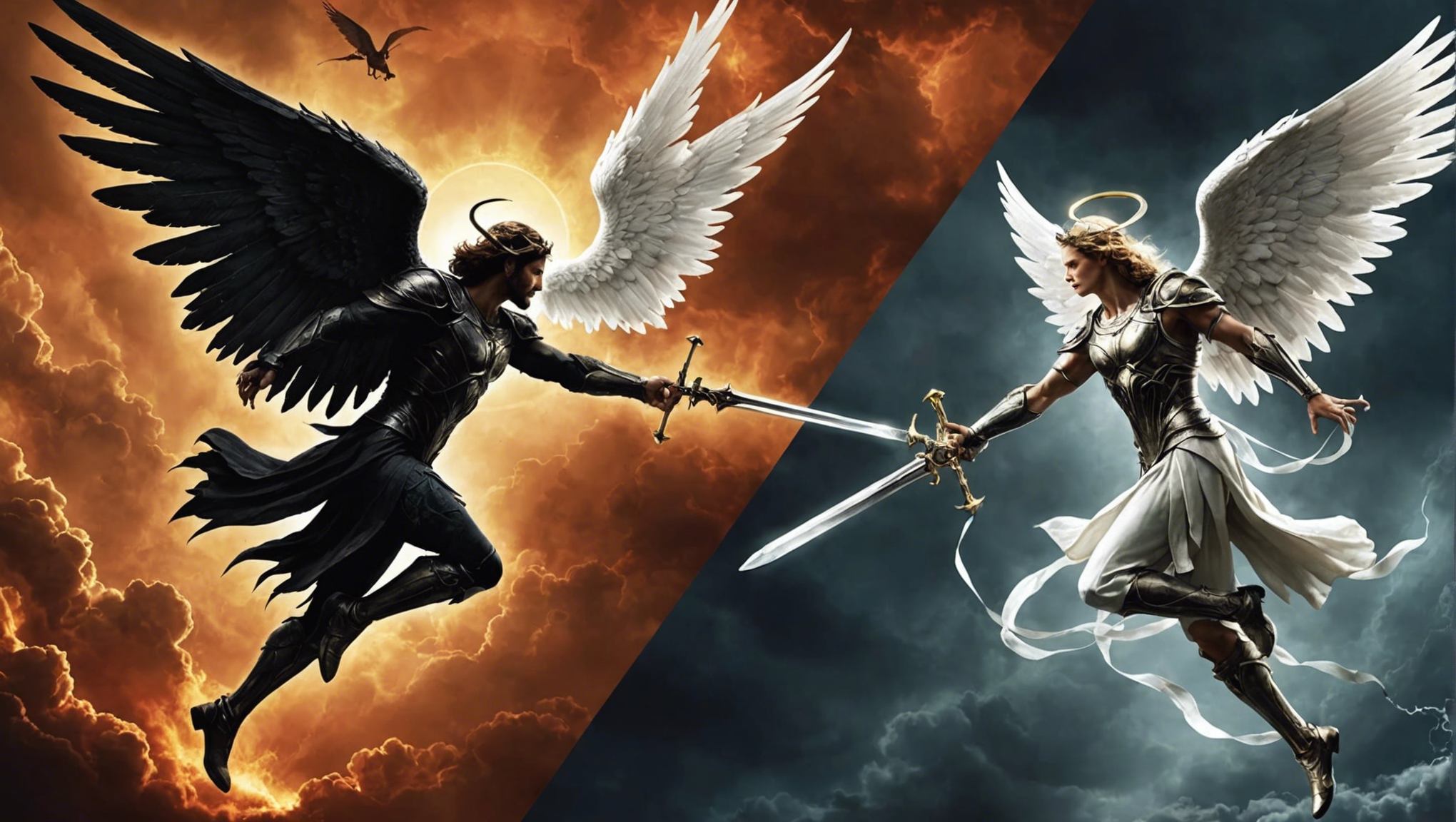In the eternal battle between Angels and Demons, what sets these mythical beings apart? Delve into the contrasting traits and characteristics that define these entities in this captivating exploration of Angels vs Demons.
Origins of Angels and Demons

Exploring the Origins of Angels
Angels have long been symbols of divine messengers in various religious beliefs, including Christianity, Judaism, and Islam. These celestial beings are described as intermediaries between God and humanity, often depicted with wings and a luminous aura. In Christian tradition, angels are believed to serve as instruments of God’s will, carrying out tasks such as delivering messages, providing protection, and guiding individuals on a spiritual path.
The concept of angels can be traced back to ancient Mesopotamian, Persian, and Egyptian mythologies, where winged deities were seen as guardians and attendants to the gods. Over time, the idea of angels evolved to reflect different cultural interpretations and beliefs, shaping their roles and characteristics in diverse ways.
Angels are generally associated with qualities such as purity, benevolence, and compassion. They are often portrayed as beings of light who offer comfort and aid to those in need, embodying the concept of divine grace and protection in the face of adversity.
Unraveling the Origins of Demons
In contrast, demons are entities often linked to darkness, temptation, and evil in many mythologies and religious traditions. These malevolent beings are believed to challenge and oppose the forces of good, tempting individuals towards sin and leading them astray from righteous paths.
The concept of demons dates back to ancient civilizations such as Sumeria, Babylon, and Assyria, where malevolent spirits were seen as causing afflictions and misfortunes among humans. In various cultures, demons have been associated with chaos, destruction, and the disruption of order.
Demons are typically depicted as twisted or monstrous figures, embodying traits of deception, malice, and corruption. They are often viewed as adversaries to both humans and divine beings, seeking to sow discord and chaos in the world.
Understanding the Contrasts
While angels and demons both exist in mythological and religious narratives, they represent contrasting forces in the cosmic balance between good and evil. Angels symbolize guidance, protection, and virtuousness, embodying the divine will and serving as beacons of hope and enlightenment.
In contrast, demons embody darkness, temptation, and malevolence, challenging moral boundaries and seeking to corrupt and destroy. The duality of angels and demons reflects the eternal struggle between light and darkness, purity and corruption, in the complex tapestry of human existence.
By exploring the origins and characteristics of angels and demons, we gain insights into the contrasting aspects of spirituality and morality that have shaped cultural beliefs and storytelling throughout history. The enduring appeal of these celestial entities lies in their ability to personify abstract concepts of good and evil, offering moral lessons and philosophical reflections on the human experience.
Powers and Abilities of Angels and Demons

Angels: Messengers and Protectors
Angels, often depicted as celestial beings in various mythologies and religions, possess a range of powers and abilities that set them apart from other supernatural entities. These divine messengers are known for their roles as intermediaries between heaven and earth, delivering messages and guidance to humans.
Powers of Angels:
– Healing: Angels are believed to possess the ability to heal physical and emotional wounds, bringing comfort and restoration to those in need.
– Protection: One of the most recognized abilities of angels is their protective nature, shielding individuals from harm and negative forces.
– Teleportation: Angels are often described as being able to move swiftly between locations, appearing and disappearing at will.
– Supernatural Strength: In times of crisis, angels are said to exhibit incredible strength, overpowering obstacles and adversaries.
Abilities of Angels:
– Wisdom: Angels are renowned for their profound wisdom and ability to offer insightful guidance to those seeking direction.
– Clairvoyance: Some angels are believed to possess the gift of clairvoyance, seeing beyond the physical realm to perceive hidden truths.
– Empathy: Angels are known for their deep empathy and compassion, understanding the emotions and struggles of humanity.
Demons: Tempters and Deceivers
In contrast to angels, demons are often portrayed as malevolent entities seeking to sow chaos and destruction. These infernal beings are associated with darkness and temptation, preying on human weaknesses for their own malevolent purposes.
Powers of Demons:
– Illusions: Demons are skilled at creating illusions and manipulating perceptions, deceiving their victims with false appearances.
– Possession: A common ability attributed to demons is the ability to possess and control individuals, influencing their thoughts and actions.
– Curses: Demons are believed to have the power to inflict curses and bring misfortune upon those they target.
– Corruption: Demons excel at corrupting purity and goodness, twisting virtues into vices and leading individuals astray.
Abilities of Demons:
– Manipulation: Demons are master manipulators, using deception and seduction to lure unsuspecting souls into their grasp.
– Fear Inducement: Demons can instill intense fear and dread in their victims, feeding off negative emotions.
– Destruction: Some demons possess the ability to unleash destructive forces, causing chaos and devastation in their wake.
Through exploring the powers and abilities of angels and demons, we gain insight into the complex dynamics between light and darkness, good and evil, in the realms of myth and folklore.
Roles in Religion and Mythology

In the realm of religion and mythology, various entities play pivotal roles, each with distinct characteristics and functions that shape the narratives they are part of. Angels and demons stand out as two contrasting figures that embody opposing forces and fulfill different purposes within different belief systems.
Characteristics of Angels
– Angels are often depicted as benevolent beings, serving as messengers of God and agents of divine will.
– They are associated with qualities such as purity, compassion, and protection, symbolizing goodness and light.
– In Christianity, angels are believed to act as intermediaries between heaven and earth, guiding and guarding individuals on their spiritual journeys.
Role of Angels in Religion and Mythology
– Angels are revered in various religions, including Christianity, Judaism, and Islam, where they are believed to carry out God’s commands and offer guidance to believers.
– They are often depicted as celestial beings who watch over humanity, offering comfort, guidance, and protection in times of need.
– In religious texts and mythological stories, angels are portrayed as powerful entities who fight against evil forces and support the forces of good.
Characteristics of Demons
– Demons are typically portrayed as malevolent beings, associated with darkness, temptation, and chaos.
– They are often depicted as antagonistic figures who seek to deceive and lead humans astray, embodying qualities such as deceit, violence, and destruction.
– In various mythologies, demons are seen as powerful entities who challenge the authority of gods and disrupt the natural order.
Role of Demons in Religion and Mythology
– Demons are often viewed as entities that test the faith and resolve of individuals, tempting them to stray from their righteous paths.
– In religious teachings, demons are seen as adversaries of divine forces, working to undermine the efforts of angels and lead humans into sinful behavior.
– Mythological depictions of demons often highlight their role as agents of chaos and disorder, posing threats to both humans and deities.
In conclusion, angels and demons embody contrasting roles in religion and mythology, representing the eternal struggle between good and evil, light and darkness. While angels symbolize purity, guidance, and protection, demons embody deceit, temptation, and destruction. Understanding the distinct characteristics and functions of these entities enriches our appreciation of the diverse narratives and beliefs across different cultures and traditions.
Moral Codes and Behaviors
Exploring Moral Codes and Behaviors
Understanding the nuances between moral codes and behaviors is essential in navigating complex ethical dilemmas. While moral codes provide a framework of principles and values that guide our conduct, behaviors manifest these principles in actions and decisions.
The Role of Moral Codes
Moral codes serve as a moral compass, shaping our beliefs and attitudes towards what is right and wrong. Rooted in cultural, religious, or philosophical beliefs, these codes set standards for ethical behavior and moral decision-making. They establish the boundaries within which our actions are evaluated and judged.
Manifestation Through Behaviors
In contrast, behaviors are the visible expressions of our internal moral codes. How we act, react, and interact with others reflects our adherence to or deviation from these moral principles. Behaviors are shaped by environmental factors, personal experiences, and social influences, translating abstract moral values into tangible actions.
Alignment and Discrepancies
While ideally, our behaviors should align harmoniously with our moral codes, discrepancies can arise. External pressures, conflicting priorities, and moral dilemmas may lead to situations where our actions deviate from our professed values. Recognizing and addressing these discrepancies is crucial for personal integrity and ethical growth.
Impact on Relationships and Society
Our moral codes and behaviors play a significant role in shaping our relationships with others and society at large. Consistent alignment between our professed values and actual behaviors fosters trust, respect, and cohesion within communities. Conversely, incongruence can lead to conflict, distrust, and societal unrest.
Cultivating Ethical Awareness
To bridge the gap between moral codes and behaviors, individuals must cultivate ethical awareness and mindfulness in their actions. Regular reflection, introspection, and conscious decision-making can help ensure that one’s behaviors align with deeply held moral principles, fostering a more ethical and cohesive society.
Depictions in Popular Culture
Angels and demons have long captivated the human imagination with their contrasting natures depicted in popular culture. From literature to film, these celestial beings and infernal creatures have been portrayed in various ways, highlighting their divergent attributes and roles in the cosmic hierarchy.
Visual Representations
When it comes to visual depictions, angels are often portrayed as ethereal beings with shimmering wings, radiant halos, and serene expressions. They exude a sense of purity, grace, and divine light, symbolizing protection, guidance, and benevolence. In contrast, demons are depicted as dark, menacing figures with twisted horns, leathery wings, and sinister grins. They embody chaos, temptation, and malevolence, instilling fear and dread in those they encounter.
Motifs and Symbols
Angelic figures are commonly associated with symbols of peace, hope, and spirituality, such as doves, harps, and white robes. They serve as messengers of God, intermediaries between heaven and earth, and guardians of humanity. On the other hand, demons are often linked to symbols of destruction, deception, and evil, such as flames, pitchforks, and black cloaks. They are depicted as agents of darkness, instigators of sin, and tormentors of souls.
Characteristics and Attributes
Angels are typically portrayed as compassionate, kind, and selfless beings who embody virtues such as love, wisdom, and courage. They offer solace to the troubled, guidance to the lost, and protection to the vulnerable. In contrast, demons are shown as manipulative, vindictive, and power-hungry entities who thrive on chaos, suffering, and corruption. They sow discord, lead astray, and revel in chaos and destruction.
Role and Function
In popular culture, angels are often depicted as guardians, mentors, and celestial warriors who fight against evil forces, protect the innocent, and guide souls to salvation. They represent hope, redemption, and the triumph of good over evil. On the other hand, demons are portrayed as tempters, tormentors, and malevolent entities who seek to corrupt souls, spread chaos, and bring about destruction. They embody the darker aspects of human nature and serve as foils to the forces of light.
Perspectives on Good and Evil
In various mythological traditions and belief systems, the concepts of good and evil play a crucial role in shaping moral frameworks and understanding the nature of the universe. Across different cultures, the depiction of good and evil beings often showcases contrasting characteristics and motivations, illustrating the eternal struggle between light and darkness.
Angelic Beings: Agents of Good
Angels, revered in many religious and spiritual traditions, are often portrayed as beings of pure light and goodness. These celestial entities are depicted as messengers of divine will, embodying virtues such as compassion, protection, and guidance. In Christian lore, angels are considered God’s servants, tasked with safeguarding humanity and delivering messages of hope and salvation.
Demonic Entities: Harbingers of Evil
In opposition to angels, demons are commonly portrayed as malevolent entities that embody the darker aspects of existence. These infernal beings are often associated with temptation, chaos, and destruction, seeking to lead mortals astray and corrupt their souls. In various mythologies, demons are depicted as antagonistic forces that thrive on fear, suffering, and chaos, representing the inherent struggle against evil in the world.
Conflict and Balance
The eternal conflict between angels and demons symbolizes the eternal struggle between good and evil in the cosmic order. This dichotomy reflects the perpetual battle between light and darkness, order and chaos, purity and corruption. It highlights the intricate balance required to maintain harmony in the universe, emphasizing the importance of free will and moral choices in determining one’s alignment with either good or evil forces.
Moral Ambiguity and Gray Areas
While angels are typically associated with goodness and demons with wickedness, many mythologies also explore the nuances of moral ambiguity and the gray areas between these extremes. Characters such as fallen angels and repentant demons challenge simplistic notions of good and evil, inviting contemplation on the complexities of redemption, forgiveness, and personal transformation.
Ultimately, the perspectives on good and evil differences in mythologies offer profound insights into the dualistic nature of human existence and the eternal quest for moral enlightenment. By examining these contrasting depictions of celestial and infernal beings, we can deepen our understanding of ethical dilemmas, spiritual growth, and the timeless struggle between virtue and vice.
